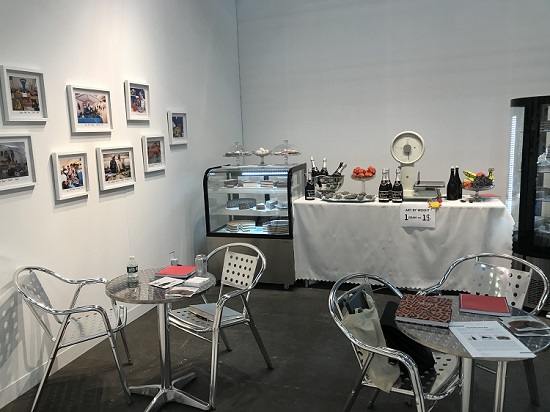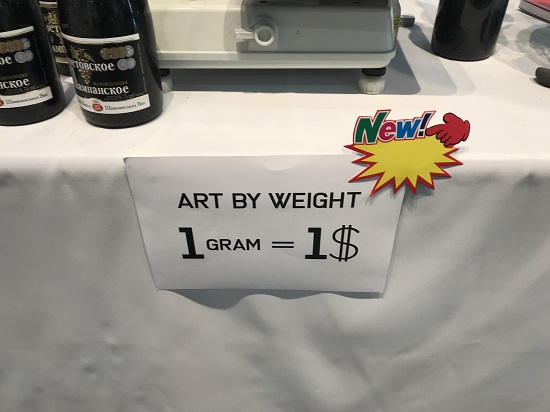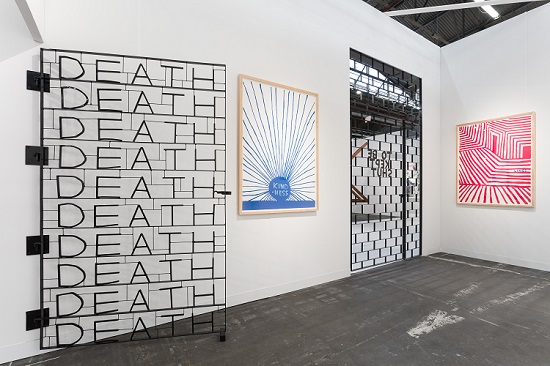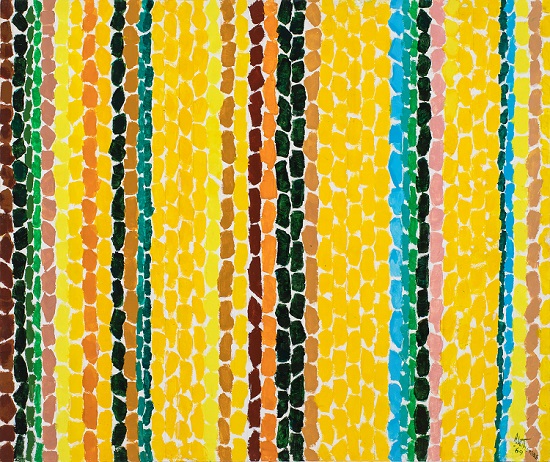The Armory Show is the largest and most varied of the art fairs that populate The Armory Show Week held in the first week of March each year. The Armory Show demonstrates significant changes annually and presents artist projects, curated sections and themes reflecting current artworld predilections. One can easily spend the day here. The show is spread over two piers: while it can be a challenge to get there, the number of galleries (and territorial expanse) is virtually inexhaustible, and with the quality of the exhibitors this year, it’s well worth the effort.
Along with some artists that are either familiar from the current New York scene, or from salient episodes of the late twentieth century, there’s much more that is surprising, and definitely varied, being from galleries around the world. There’s a great balance here between new and old: it’s all about the art, with something tantalizing and unexpected around every corner: this fair provides refreshment and enticement at every turn.
Following are my selections of the three best artworks and two superb booths at The Armory Show 2020.
The Caddy Court by Edward Kienholz and Nancy Reddin Kienholz
Pier 94 – Town Square
The Caddy Court, 1986-87, by the late California artists Edward Kienholz (1929-94) and Nancy Reddin Kienholz (1943-2019), is presented by LA Louver Gallery of Los Angeles in The Armory's Platform Sector. Those two artists, were among the first well known installation artists, gathering the flotsam and jetsam of everyday life, essentially junk, into such compelling and at times eerie, or macabre, pieces as The Wait, long a fixture at the old uptown Whitney Museum.
The Caddy Court’s theme is the US Supreme Court. Providing insight into the work, which dates from almost four decades ago, was described by the artists in an exhibition brochure from LA Louver Gallery, “What we’re trying to do is make visible the rush of fear that most people have when you mention the Supreme Court.”
This piece is gigantic and fills the central intersection of the fair’s gallery lined corridors, a spot described as the fair’s “town square.” The Caddy Court features a shiny white stretch version of the eponymous vehicle, an impeccable 1978 Cadillac, into whose middle is spliced a 1966 Dodge van. The doors reconfigure of the Supreme Court façade, and visitors pass through a curtain lined law library into the piece’s darkened interior.
As if looking at characters onstage in a play, you are confronted with the spectral image of taxidermized animals (sizable moose, elk, deer – with antlers, a bear, possibly a hippo with horns, and two or three giant animal skulls), dressed in black judicial robes, gesturing at each other and the viewers, menacingly wielding their gavels. They look slightly decomposed, which adds to the sought after horrific effect.
A piece that stops you in your tracks and just demands to be looked at, The Caddy Court feels quite current though it’s truly retro. I overheard one viewer explaining to his companion that these artists (both deceased) were “the angry Rauschenberg.” Added touches on The Caddy Court include a silver cherub—blindfolded and one-armed as a hood ornament upon whom twisted scales of justice are draped—a checkerboard racing stripe with historic portraits of the judges onward from 1790; and Idaho license plates that say “CCourt.”
.

"The Caddy Court" by Edward Kienholz and Nancy Reddin Kienholz, 1986-87. Exhibited at The Armory Show 2020 by LA Louver Gallery. Courtesy of The Armory Show and the gallery.
.
The Market by Zhanna Kadyrova
Pier 94 - Booth P3
A gallery I had never heard of, Voloshyn Gallery, from Ukraine (among the 30 galleries who have not previously participated in the fair, and the first to do so from Ukraine) presented a piece that charmed me. The artist, Zhanna Kadyrova presided over her full-booth scale installation, The Market (2017-2020). Its manner of presenting sculptural depictions of food was reminiscent of Oldenburg’s The Store, 1961, but rather than roughly expressionistic, the treatment was cool, crisp, elegant and quite appealing, in the manner of a pared down version of such a Madison Avenue shop as St. Ambroeus.
Visitors from a distance saw what appeared to be a typical food display counter like so many others at the fair, presenting cakes and pastries along with attractive champagne bottles. The Armory’s press release explains that the labels on the bottles indicate champagne actually produced in Ukraine rather than the ‘Soviet” champagne of the prior regime. It was easy to be fooled into thinking that all this was the real thing. One visitor definitely was, which I witnessed.
.

"The Market" by Zhanna Kadyrova exhibited by Voloshyn Gallery at The Armory Show 2020. Photo by Franklin Hill Perrell.
.
Of course, it’s not immediately evident that these inedible, but convincing, desserts were sculpted out of construction waste, concrete, and ceramic. A handmade sign announced Art by Weight 1 gram = 1$. Everything at these fairs is, of course, for sale, so this rather forthright advertising contrasts the otherwise mysterious machinations of arts financial side where prices are only rarely posted. The Market is also a type of performance piece, with the artist dressed as a shop counter saleswoman and photographs of her “at work” in art fairs around the world.
.

Detail from "The Market" by Zhanna Kadyrova, 2017-2020, exhibited by Voloshyn Gallery at The Armory Show 2020. Courtesy of The Armory Show and the gallery.
.

Detail of "The Market" by Zhanna Kadyrova exhibited by Voloshyn Gallery at The Armory Show 2020. Photo by Franklin Hill Perrell.
.
Death Gate by David Shrigley
Pier 94 - Booth 901
A neon light sign proclaims the word “Believe” in bold letters in a work by artist Kendall Geers pulled me in to the booth of London’s Stephen Friedman Gallery. Strikingly, nearby, was Denzil Forrester’s painting, From Trench Town to Porthtowan, 2017. This beach scene, so current in its configuration, gives a contemporary spin to the time honored post-Impressionist theme of leisure on the beach. Its pastel palette and closely hued tonal range really marked the work as a painter’s painting.
.

"From Trench Town to Porthtowan" by Denzil Forrester, 2017. Oil on canvas, 50 1/4 x 63 3/4 inches. Copyright Denzil Forrester. Courtesy the artist and Stephen Friedman Gallery, London.
.
Further inside the Friedman booth was the thought provoking installation by British artist David Shrigley titled Death Gate. A wrought-iron style door with the letters “DEATH” repeated on horizontal bars opens on to an all-white room with large childlike drawings (in red or blue on white) by the artist along with a collection of sculptures, bold forms in black or white, some suggesting bombs, missiles, an egg, quirky figures or other emblems. Their nonchalance, displayed like collectibles on shelves, belies the implication of violence.
.

Installation view of at by David Shrigley exhibited by Stephen Friedman Gallery at The Armory Show New York 2020. Courtesy Stephen Friedman Gallery, London Photo by Mark-Blower.
.
Shrigley’s approach, redolent of innocence and naiveté, presents an ironic contrast to the sharp social comment of his work, a point evident in his recent New York exhibition, "FLUFF WAR," at Anton Kern Gallery.
BEST BOOTH – MODERN ART
Pier 94 - Booth 508
For a more traditional booth display, there is none better than that at the Michael Rosenberg Gallery. I was drawn in by one of the late artist Benny Andrew’s colorful paintings. Within, I saw an array of individually compelling works arranged by a theme of comparisons, aesthetic affinities of imagery, color, style, texture, or other particulars. It was very engaging.
A painting by Alma Thomas was juxtaposed to one by Joan Mitchel (strong color and gestural brushstrokes); a construction by Alphonso Ossorio with a collage by Richard Pousette-Dart (both dark in tone, heavily wrought, intimate abstract collage/assemblage pieces), Adolph Gottlieb with Norman Lewis (gestural pictograms on fields of color), and sculptural art in boxes by Hannelore Baron and Mary Bauermeister. I was reminded of some of the juxtapositions now provoking interest at MOMA, like paintings by Faith Ringgold with Picasso, or Alma Thomas with Matisse.
.

Alma Thomas (1891–1978), "Forsythia Glow in Washington DC," 1969. Acrylic and graphite on canvas, 34 x 40 inches, signed. Courtesy of Michael Rosenfeld Gallery LLC, New York, NY.
.
At Rosenfeld, this approach is especially successful because the aesthetic link between the works is so explicit and fine-tuned. One section I particularly liked was relating a somewhat pointillist, primarily yellow, abstraction by Alma Thomas with Beauford Delaney’s heavily textured, expressionist fauve painting, Untitled (Still Life with Idol) from 1945.
.

Beauford Delaney, (1901–1979),Beauford Delaney, (1901–1979), "Untitled (Still Life with Idol)," 1945. Oil on canvas, 18 1/4 x 24 1/4 inches, signed. © Estate of Beauford Delaney by permission of Derek L. Spratley, Esquire, Court Appointed Administrator; Courtesy of Michael Rosenfeld Gallery LLC, New York, NY. © Estate of Beauford Delaney by permission of Derek L. Spratley, Esquire, Court Appointed Administrator; Courtesy of Michael Rosenfeld Gallery LLC, New York, NY.
.
The wow factor was inescapable here. Along with much else, the booth concludes with a mosaic style installation wall of uniformly framed works on paper by multiple artists (including Romare Bearden, Hans Hoffman, Bill Traylor, Morris Graves, and Bob Thompson), all of these resonate in relationship to each other while maintaining their individual identities and intrigue. This is a particularly pleasing display, a type of mini museum of some of the more enduring original styles arising from post-war American art.
BEST SOLO BOOTH
Pier 90 - Booth 515
Pier 90 looks smaller on the art fair map but has just as much to look at. Amidst curated sections, there are many galleries quite well known to New York Gallery goers. I was particularly drawn to the display of Duane Michals photographs at DC Moore Gallery. The gallery presents two series by Duane Michals in its main space, along with several other rather surreal works by the photographer around the corner.
The series “Empty New York” is prominent in DC Moore Gallery's main exhibition space in its booth. This series of intimate photos deals with imagery of early morning New York, dating from the 1964-65. These vintage gelatin silver prints of unpeopled Laundromats, barbershops, and shoe shine stations portray a more peaceful world than that of today, rather clean, orderly images of day to day places, otherwise empty, awaiting impending activity. Their quality of shadow and light, the lack of people, and familiar if nostalgic imagery, projects a Hopper-esque atmosphere, though one of mystery rather than alienation.
Nearby, there is also a wall of artist portraits, mostly from around the same time. One of Andy Warhol, young and thoughtful, posed in front of a wall of Campbell Soup cans, is especially appealing.
.

"Andy Warhol" by Duane Michals, 1962. Gelatin silver print with hand-applied text, 13 1/2 x 9 inches. Courtesy DC Moore Gallery.
.
The portrait photo of Joseph Cornell is a particular stand-out. It is a quite famous portrait: the figure of Cornell, slightly cropped, looks down across an interior onto an expanse of softly folded sheets, in silver tones of grey, spread out across an empty bed like gentle ocean waves reflecting moonlight. The room’s window is open and crisscrossed by diaphanous curtains. Cornell’s own image becomes absorbed into this setting, evocative of the surreal dream-like imagery of the artist’s work and its shadow box-like space.
Perhaps the Cornell is good emblem for the fair itself: a visionary looking across a field of wonders, conjuring images from the imagination, at times connected or not to external reality, but positioned at the intersection of an artist created world, one of visual invention and imagination.
.

"Joseph Cornell" by Duane Michaels, 1972/c. 2000s. Gelative silver print with hand-applied text, 6 3/4 x 9 3/4 inches. Courtesy DC Moore Gallery.
.
_____________________
BASIC FACTS: The Armory Show is presented March 5 to 8, 2020 on Piers 90 and 94 located at 711 12th Avenue, New York, NY 10019. To purchase tickets online, click here. www.thearmoryshow.com.
_______________________
Copyright 2020 Hamptons Art Hub LLC. All rights reserved.
